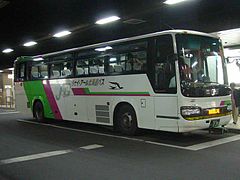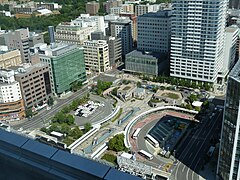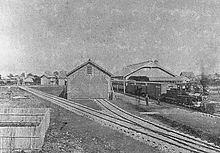Sapporo train station
| Sapporo ( 札幌 ) | |
|---|---|
 South entrance with JR Tower (October 2009)
|
|
| Data | |
| Location in the network | Through station |
| Platform tracks | 10 |
| abbreviation | 01 |
| opening | November 28, 1880 |
| location | |
| City / municipality | Sapporo |
| prefecture | Hokkaidō |
| Country | Japan |
| Coordinates | 43 ° 4 '7 " N , 141 ° 21' 3" E |
| Height ( SO ) | 18 m TP |
| Railway lines | |
|
|
| List of train stations in Japan | |
The Sapporo Station ( Japanese 札幌 駅 , Sapporo-eki ) is a train station on the Japanese island of Hokkaidō . It is located in the center of Sapporo in the Chūō-ku district and is the main rail transport hub of Hokkaidō. The station operated by the company JR Hokkaido is served by trains on the Hakodate Main Line , the Chitose Line and the Sasshō Line . It is also connected to two lines on the Sapporo subway . The ten-track system is part of an extensive building complex that includes several shopping centers , the JR Tower and a bus station .
For better differentiation, the station name in the railway section is written in Kanji characters , while the Hiragana script is used for the subway section ( さ っ ぽ ろ ).
links
Sapporo is on the Hakodate Main Line from Hakodate to Asahikawa , Hokkaidō's main railway line. The Chitose Line and the Sasshō Line also branch off nearby . The station is by far the most important on JR Hokkaido, no other station is served by nearly as many trains. All larger cities on the island can be reached from here without changing trains.
On the Hakodate main line to the east, the Super Kamui electric express train, which runs every 30 or 60 minutes, provides the fastest connection with Asahikawa , with a journey time of one hour and 25 minutes for the 136.8 km route. The diesel-powered express trains Super Sōya and Sarobetsu to Wakkanai and Ochotsk to Abashiri run several times a day on this route . On certain days in summer the “Lavender Express” goes to Furano . In a westerly direction, the Niseko Liner runs once a day to Kutchan .
On the Chitose line, the diesel-powered Hokuto and Super Hokuto express trains run to Hakodate every one to two hours , supplemented by the electric Suzuran express trains to Muroran . There are also the Super Dieselzora diesel express trains to Kushiro and Super Tokachi to Obihiro several times a day . The Airport Liner , which runs electrically every 15 to 30 minutes, connects Otaru with Sapporo and New Chitose Airport .
In local traffic, regional trains run at frequent intervals to Hokkaidō-Iryōdaigaku on the Sassō line, Iwamizawa and Otaru on the Hakodate main line and Tomakomai on the Chitose line. Express trains called Ishikari Liner run from Otaru via Sapporo to Iwamizawa .
The Esta building (the name is derived from the Spanish estación ) adjacent to the train station houses a bus station on the first floor . It has three bus platforms with a total of 18 stops and is served by more than 70 city, regional and long-distance bus routes as well as sightseeing buses. 36 bus routes stop in the streets in front of the south entrance of the station, and 17 more on the north station forecourt. Mainly represented are the companies Hokkaidō Chūō Bus , Jotetsu Bus and JR Hokkaidō Bus .
investment
The station is on the northern edge of the city center. The extensive campus of the University of Hokkaidō extends northwest of it . Sapporo is a through station oriented from west to east , which is completely enclosed by a station hall ; its roof is used as a parking lot . Eleven tracks run through the station, ten of which are used for passenger traffic. These are located on five central platforms , on the northernmost platform 11 it is not possible to get on and off. The tracks and platforms are elevated on a viaduct , while the ground floor is used as a distribution level . Various service facilities, restaurants and kiosks can be found there. The main exits are in the north and south.
From the outside, the actual train station can hardly be seen as it is almost completely surrounded by other buildings. The facility is dominated by the JR Tower , the tallest building in Hokkaidō. It stands on the southeast corner, has 38 floors and is 173 meters high; on the top floor there is a viewing platform. The Paseo shopping center (Spanish for “promenade”) extends along the entire north side of the station on several floors ; it has over 200 shops and there is a tourist information center on the ground floor. The Stellar Place shopping center is located between the platforms and the southern exit . Some of the 200 shops are located on balconies that are arranged around a central square; a multiplex cinema with twelve halls can be found on the seventh floor . South of the JR Tower is the Esta department store , and the Daimaru department store (for high demands) on the southwest corner of the station .
In the 2014 fiscal year, an average of 93,313 passengers per day were counted, making Sapporo by far the most frequented train station in JR Hokkaido.
Subway
Sapporo station is served by two lines of the Sapporo subway , the Namboku line and the Tōhō line . They both run in a north-south direction and are about 200 meters apart (the Namboku line under the western part of the station, the Tōhō line under the eastern part). The underground stations are not located directly under the station, but about 250 meters south of it. The station of the Namboku line can be reached through the Apia shopping arcade (with a little more than 100 shops) and the station of the Tōhō line through another tunnel. Both underground stations are connected underground to the bus station in the Esta building.
Under the Ekimae-dōri ("Bahnhofstrasse") and above the tunnel of the Namboku line, the 520-meter-long Chikaho pedestrian passage runs south to near the next but one station, Susukino. At the Ōdōri station in between, it is connected to the underground shopping arcades Aurora and Pole Town to form a kind of underground city that offers protection from the harsh winter climate.
The first section of the Namboku Line from Kita-nijūyo-jō to Makomanai opened on December 16, 1971, seven weeks before the 1972 Winter Olympics began . On December 2, 1988, the first section of the Tōhō line between Sakaemachi and Susukino-Hōsui followed.
Tracks
| 1-3 | ▉ Hakodate main line | Teine • Otaru |
| 4th | ▉ Chitose line | Minami-Chitose • New Chitose Airport • Tomakomai |
| ▉ Sasshō line | Ishikari-Tōbetsu • Hokkaidō-Iryōdaigaku | |
| 5/6 | ▉ Chitose line | Minami-Chitose • New Chitose Airport • Tomakomai |
| 7/8 | ▉ Hakodate main line | Iwamizawa • Takikawa • Asahikawa |
| 9/10 | ▉ Hakodate main line | Iwamizawa • Takikawa • Asahikawa |
| ▉ Sasshō line | Ishikari-Tōbetsu • Hokkaidō-Iryōdaigaku |
history
The state railway company Horonai Tetsudō opened on November 28, 1880 the first section of the Hakodate main line between Sapporo and Minami-Otaru , together with the subsequent Temiya line to the port of Otaru . It was the first railway line on Hokkaidō. In Sapporo there was initially a demand stop at the current location . The railway company began handling goods in August 1881 and in January 1882 Sapporo received a permanent station with the opening of a reception building . On June 25, 1882, the line was extended in an easterly direction to Ebetsu .
After the Horonai Tetsudō had been sold to the private mining and railway company Hokkaidō Tankō Tetsudō in 1889 , the new owner expanded the reception building in the first half of 1890. In the fall of 1898 she built a pedestrian overpass on the west side of the facility. On October 1, 1906, the Hokkaidō Tankō Tetsudō became state property. The station building was destroyed by fire in October 1907, and the replacement building that was subsequently built was opened on December 5, 1908. It had a western American style and was equipped with half-timbering and red-roofed gable roofs . In the second half of 1909, the Railway Authority (later the Ministry of Railways ) expanded the Zenibako – Sapporo – Nopporo line to double track.
In February 1949 a second pedestrian overpass was built on the east side of the facility, and from June 1949 the Japanese State Railways was responsible for the station. This tore down the station building from 1908 and replaced it with a four-storey new building, which was opened in December 1952. A department store was also integrated into the new station . On June 1, 1958, the state railway stopped handling goods at Sapporo station. In 1963 he received a second station building on the north side, while the building on the south side was increased by one floor two years later. In March 1972, an underground shopping mall was added (today's Apia ), and in September 1978 the Esta shopping center on the southeast side .
In November 1978, a complete renovation of the station began, which had increasingly developed into a bottleneck. While operations continued, the tracks and platforms were laid on a wide viaduct, while a distribution level was created at floor level . This work took over ten years. With the privatization of the state railway on April 1, 1987, the station became the property of the new company JR Hokkaido . The first stage of the renovation was completed on November 3, 1988: Tracks 3 to 11 were now completely in an elevated position, as was the Sapporo – Kotoni section to the west. The Paseo shopping center on the north side of the train station opened on the same day . The new tracks 1 and 2 were operational on September 1, 1990 and the section between Sapporo and Sōen received a third track on November 1, 1994 for the trains of the Sasshō line. Work on the JR Tower began in March 2000 and was completed three years later. In March 2011, the Chikaho underground pedestrian passage was opened.
future
The high-speed Hokkaidō-Shinkansen line from Shin-Hakodate-Hokuto to Sapporo is currently being extended. The new line is to be opened in 2031. How it should be led into the station has not yet been finally clarified. There are two main options under discussion: The prefectural and city authorities and the infrastructure company JRTT prefer to convert tracks 1 and 2 on the south side for the sole use of Shinkansen traffic. However, this would lead to a reduction in capacity for the rest of the rail traffic, which could only be avoided by building an additional platform on the north side. JR Hokkaido, on the other hand, prefers to build an underground Shinkansen station east of the existing facility, but this would be very costly.
Adjacent train stations
|
←
|
Lines |
→
|
||
|---|---|---|---|---|
| Soen |
JR Hokkaido |
Naebo | ||
| Soen |
JR Hokkaido |
The End | ||
| Beginning |
JR Hokkaido |
Naebo | ||
| Kita-jūni-jō |
Subway Sapporo |
Ōdōri | ||
| Kita-jūsan-jō-higashi |
Sapporo Subway |
Ōdōri | ||
Web links
- Sapporo Station Guide (English)
- JR Hokkaido Station Information (Japanese)
Individual evidence
- ^ JR Hokkaido railway lines in Sapporo area. (PDF, 986 kB) JR Hokkaido, accessed on July 27, 2016 (English).
- ↑ Overview map of bus transport to Sapporo station. (No longer available online.) City of Sapporo, 2016, archived from the original on July 27, 2016 ; Retrieved July 27, 2016 (Japanese).
- ^ Layout and Facilities. Sapporo Station Guide, 2016, accessed July 27, 2016 .
- ↑ Entry about JR Tower at Emporis
- ↑ Shopping Near Sapporo Station. Sapporo Station Guide, 2016, accessed July 27, 2016 .
- ↑ 会 社 概要 (company profile). JR Hokkaido, 2015, accessed July 27, 2016 (Japanese).
- ↑ Sapporo Ekimae-dori underground walkway (Chi-Ka-Ho). City of Sapporo, accessed July 27, 2016 .
- ^ Sapporo. urbanrail.net, 2011, accessed on July 27, 2016 (English).
- ↑ a b c Japanese State Railways (ed.): 札幌 駅 80 年 史 (80 years of history of the Sapporo station), 1960.
- ↑ Kazuo Tanaka: 写真 で 見 る 北海道 の 鉄 道 (Hokkaidō's railroad in photos) . tape 1 . Hokkaidō Shinbunsha, Sapporo 2002, ISBN 978-4-89453-220-5 , pp. 36-37 .
- ↑ Kōtsū Shinbun (Ed.): JR7 社 14 年 の あ ゆ み (14 years of history of the seven JR companies) . Transportation News Co., Tokyo May 2, 2001, p. 9 .
- ↑ Japan To Move Up Opening Of New Bullet Train Lines In Hokkaido, Hokuriku. Japan Bullet, January 9, 2015, accessed July 27, 2016 .
- ↑ 新 幹線 札幌 駅 ホ ー ム 案 迷 走 機構 や 市 「現 駅」 / JR 「東側」. Hokkaidō Shimbun, July 3, 2016, archived from the original on July 27, 2016 ; Retrieved July 27, 2016 (Japanese).












